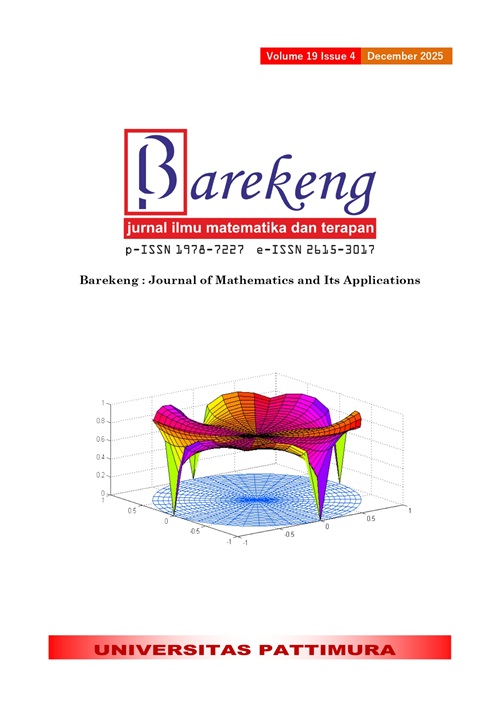COMPARISON OF THE VOLATILITY OF GARCH FAMILY MODEL IN THE CRYPTOCURRENCY MARKET: SYMMETRY VERSUS ASYMMETRY
Abstract
Cryptocurrencies can be considered an individual asset class due to their distinct risk/return characteristics and low correlation with other asset classes. Volatility is an important measure in financial markets, risk management, and making investment decisions. Different volatility models are beneficial tools to use for various volatility models. The purpose of this study is to compare the accuracy of various volatility models, including GARCH, EGARCH, and GJR-GARCH. This study applies these volatility models to the Bitcoin, Ethereum, and Litecoin return data in the period January 1st, 2020, to December 31st, 2024. The performance of these models is based on the smallest AIC value for each model. The results of the study indicate that the GARCH (1,1) is the most suitable model for Bitcoin, Litecoin, and Ethereum returns.
Downloads
References
M. J. Hossain, S. Akter, and M. T. Ismail, “PERFORMANCE ANALYSIS OF GARCH FAMILY MODELS IN THREE TIME-FRAMES,” J. Ekon. Malays., vol. 55, no. 2, pp. 15–28, 2021.doi: https://doi.org/10.17576/JEM-2021-5502-2
G. P. Dwyer, “THE ECONOMICS OF BITCOIN AND SIMILAR PRIVATE DIGITAL CURRENCIES,” J. Financ. Stab., vol. 17, pp. 81–91, 2015.doi: https://doi.org/10.1016/j.jfs.2014.11.006
A. H. Dyhrberg, “BITCOIN, GOLD AND THE DOLLAR–A GARCH VOLATILITY ANALYSIS,” Finance Res. Lett., vol. 16, pp. 85–92, 2016.doi: ttps://doi.org/10.1016/j.frl.2015.10.008
A. Ngunyi, S. Mundia, and C. Omari, “MODELLING VOLATILITY DYNAMICS OF CRYPTOCURRENCIES USING GARCH MODELS,” 2019.doi: https://doi.org/10.4236/jmf.2019.94030
J. Chu, S. Chan, S. Nadarajah, and J. Osterrieder, “GARCH Modelling Of Cryptocurrencies,” J. Risk Financ. Manag., vol. 10, no. 4, p. 17, 2017.doi: ttps://doi.org/10.3390/jrfm10040017
P. Katsiampa, “VOLATILITY ESTIMATION FOR BITCOIN: A COMPARISON OF GARCH MODELS,” Econ. Lett., vol. 158, pp. 3–6, 2017.doi: https://doi.org/10.1016/j.econlet.2017.06.023
S. A. Gyamerah, “MODELLING THE VOLATILITY OF BITCOIN RETURNS USING GARCH MODELS,” Quant. Finance Econ., vol. 3, no. 4, pp. 739–753, 2019.doi: https://doi.org/10.3934/QFE.2019.4.739
E. Endri, Z. Abidin, T. P. Simanjuntak, and I. Nurhayati, “INDONESIAN STOCK MARKET VOLATILITY: GARCH MODEL,” Montenegrin J. Econ., vol. 16, no. 2, pp. 7–17, 2020.doi: https://doi.org/10.14254/1800-5845/2020.16-2.1
C. Conrad, A. Custovic, and E. Ghysels, “LONG-AND SHORT-TERM CRYPTOCURRENCY VOLATILITY COMPONENTS: A GARCH-MIDAS ANALYSIS,” J. Risk Financ. Manag., vol. 11, no. 2, p. 23, 2018.doi: https://doi.org/10.3390/jrfm11020023
A. García-Medina and E. Aguayo-Moreno, “LSTM–GARCH HYBRID MODEL FOR THE PREDICTION OF VOLATILITY IN CRYPTOCURRENCY PORTFOLIOS,” Comput. Econ., vol. 63, no. 4, pp. 1511–1542, 2024.doi: https://doi.org/10.1007/s10614-023-10373-8
N. K. Enumah and H. S. Adewinbi, “AN ANALYSIS OF THE EXCHANGE RATE VOLATILITY IN POLAND USING THE GARCH, GJR-GARCH AND EGARCH MODELS,” Earthline J. Math. Sci., vol. 11, no. 2, pp. 287–302, 2023.doi: https://doi.org/10.34198/ejms.11223.287302
S. Mortimore and W. Sturehed, “VOLATILITY MODELLING IN THE SWEDISH AND US FIXED INCOME MARKET: A COMPARATIVE STUDY OF GARCH, ARCH, E-GARCH AND GJR-GARCH MODELS ON GOVERNMENT BONDS,” 2023.
D. Y. Dalimunthe, E. Kustiawan, N. Halim, and H. Suhendra, “VOLATILITY ANALYSIS AND INFLATION PREDICTION IN PANGKALPINANG USING ARCH GARCH MODEL,” BAREKENG J. Ilmu Mat. Dan Terap., vol. 19, no. 1, pp. 237–244, 2025.doi: https://doi.org/10.30598/barekengvol19iss1pp237-244
A. Harvey and G. Sucarrat, “EGARCH MODELS WITH FAT TAILS, SKEWNESS AND LEVERAGE,” Comput. Stat. Data Anal., vol. 76, pp. 320–338, 2014. doi : https://doi.org/10.1016/j.csda.2013.09.022
E. P. Sirait, Y. Salih, and R. A. Hidayana, “INVESTMENT PORTFOLIO OPTIMIZATION MODEL USING THE MARKOWITZ MODEL,” Int. J. Quant. Res. Model., vol. 3, no. 3, pp. 124–132, 2022.doi: https://doi.org/10.46336/ijqrm.v3i3.344
F. Black, “THE PRICING OF COMMODITY CONTRACTS,” J. Financ. Econ., vol. 3, no. 1–2, pp. 167–179, 1976.doi: ttps://doi.org/10.1016/0304-405X(76)90024-6
R. F. Engle and V. K. Ng, “MEASURING AND TESTING THE IMPACT OF NEWS ON VOLATILITY,” J. Finance, vol. 48, no. 5, pp. 1749–1778, 1993.doi: https://doi.org/10.1111/j.1540-6261.1993.tb05127.x
M. Epaphra, “MODELING EXCHANGE RATE VOLATILITY: APPLICATION OF THE GARCH AND EGARCH MODELS,” J. Math. Finance, vol. 7, no. 01, p. 121, 2017.doi: https://doi.org/10.4236/jmf.2017.71007
A.-R. B. Yussif, S. T. Onifade, A. Ay, M. Canitez, and F. V. Bekun, “MODELING THE VOLATILITY OF EXCHANGE RATE AND INTERNATIONAL TRADE IN GHANA: EMPIRICAL EVIDENCE FROM GARCH AND EGARCH,” J. Econ. Adm. Sci., vol. 40, no. 2, pp. 308–324, 2024.doi: https://doi.org/10.1108/JEAS-11-2020-0187
H. Yıldırım and F. V. Bekun, “PREDICTING VOLATILITY OF BITCOIN RETURNS WITH ARCH, GARCH AND EGARCH MODELS,” Future Bus. J., vol. 9, no. 1, p. 75, 2023.doi: https://doi.org/10.1186/s43093-023-00255-8
F. Mostafa, P. Saha, M. R. Islam, and N. Nguyen, “GJR-GARCH VOLATILITY MODELING UNDER NIG AND ANN FOR PREDICTING TOP CRYPTOCURRENCIES,” J. Risk Financ. Manag., vol. 14, no. 9, p. 421, 2021.doi: https://doi.org/10.3390/jrfm14090421
I. S. Mubarokah, A. Fitrianto, and F. M. Affendi, “PERBANDINGAN MODEL GARCH SIMETRIS DAN ASIMETRIS PADA DATA KURS HARIAN,” Indones. J. Stat. Its Appl., vol. 4, no. 4, pp. 627–637, 2020.doi: https://doi.org/10.29244/ijsa.v4i4.709
Copyright (c) 2025 Asysta Amalia Pasaribu, Aminatus Sa'adah

This work is licensed under a Creative Commons Attribution-ShareAlike 4.0 International License.
Authors who publish with this Journal agree to the following terms:
- Author retain copyright and grant the journal right of first publication with the work simultaneously licensed under a creative commons attribution license that allow others to share the work within an acknowledgement of the work’s authorship and initial publication of this journal.
- Authors are able to enter into separate, additional contractual arrangement for the non-exclusive distribution of the journal’s published version of the work (e.g. acknowledgement of its initial publication in this journal).
- Authors are permitted and encouraged to post their work online (e.g. in institutional repositories or on their websites) prior to and during the submission process, as it can lead to productive exchanges, as well as earlier and greater citation of published works.






1.gif)



